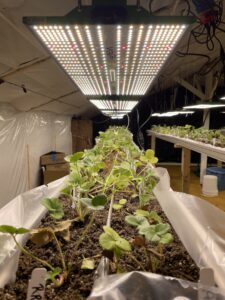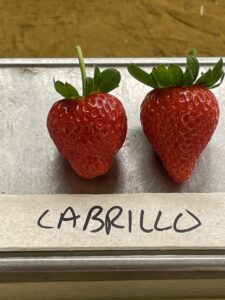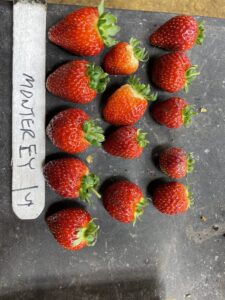Final report for ONE22-417
Project Information
When poultry growers lose a contract to grow chickens for an integrator, these poultry houses are retired or are left unused, and income is lost. There are over 1200 such houses on the Delmarva peninsula. There is interest in converting these houses into indoor lighted hydroponic growing facilities as a new income source. Currently, research on indoor lighted strawberry production is very limited. In this project, University of Delaware researchers conducted trials on indoor production of strawberries including cultivar evaluations, lighting, nutrient programs, media, drainage, and plant growth management in a converted poultry house. Day neutral varieties tested included Albion, Sweet Ann, Royal Royce, Cabrillo, Monterrey, and San Andreas. June bearing varieties tested included Camarosa, Camino Real, Flavorfest, Keepsake, Ruby June, and Fronteras. The growing system was 6" x 6" gutters filled with hydroponic greenhouse media. Standard hydroponic nutrient solution for greenhouse strawberries was used. LED lights providing 650 PPFD lighting was used with 14 hour daylengths. Temperatures were set for 65 F night and 72 F day. From these experiments, the 6 day neutral varieties were selected for a growing trial and plants were fruited from June 15 to August 17. The production trial showed that 3 varieties had the most potential: Cabrillo, Royal Royce, and Monterrey. It is estimated that in a 10 month growing cycle, approximately 4 lbs. of marketable strawberries could be produced per plant. The most common size poultry house not longer being used for bird production is 550' x 40'. In this area, 12,000 plants could be grown and would have the potential to produce 48,000 lbs. of strawberries per year with a direct marketing value of over $150,000. Electric costs in the current system for lighting and ventilation are estimated at $4,000 per month and heating at $1,000 per month only in winter months. Full house retrofit costs are estimated at $220,000.
This project seeks to create a research base for lighted indoor hydroponic production of strawberries in a retrofitted poultry house and to provide that information to potential growers.
Objective 1. To evaluate different cultivars for adaptability to the indoor production system for productivity and taste.
Objective 2. To evaluate different planting densities to optimize production and quality
Objective 3. To evaluate different lighting regimes to optimize production and quality
Objective 4. To evaluate cooling efficiency of repurposed poultry ventilation equipment on strawberries
Objective 5. To educate potential growers with empty poultry houses on successful house conversion and strawberry production.
When poultry growers lose a contract to grow chickens for an integrator, these poultry houses are retired or are left unused, and income is lost. There are over 1200 such houses on the Delmarva peninsula. There is interest in converting these houses into indoor lighted hydroponic growing facilities as a new income source. The long-term vision of Owens Premium Produce is to create opportunities for farmers with retired poultry houses to profit by growing produce for regional markets. To do so, Owens Premium Produce partnered with the University of Delaware Cooperative Extension Fruit and Vegetable program to provide research, and outreach for prospective growers.
A demonstration unit for lighted indoor hydroponic production of strawberries was created in a retrofitted poultry house.
Protected culture of strawberries is a growing field with most production occurring in the field under low tunnels of in high tunnels. More recently, attention as been paid to greenhouse production of strawberries in off seasons with greenhouse growers marketing strawberries as locally grown.
Interest has been growing for lighted indoor production of strawberries using existing facilities such as warehouses. This project assessed the potential of using empty poultry houses for that production.
Currently, research on indoor lighted strawberry production is very limited. In this project, University of Delaware researchers conducted trials on indoor production of strawberries including cultivar evaluations, lighting, nutrient programs, media, drainage, and plant growth management. Information from these efforts will be extended through electronic resources, field days, grower informational meetings, and on-farm sessions. An additional goal is to demonstrate how to convert a poultry house to address food safety concerns for produce production.
Delmarva is adjacent to large markets and year-round production of strawberries in these retrofitted poultry houses could provide premium product to these regional markets rather than shipping from California, Mexico, or Florida.
Cooperators
- (Researcher)
- - Producer
Research
To evaluate different cultivars for adaptability to the indoor production system a 6-month set of experiments and production trials was conducted
Variety trial
The initial trial was was a replicated variety trial set up using 12 different varieties of strawberries. Strawberries were selected according to past research and availability and consisted of repeat blooming types (day neutrals) and June bearing types. Day neutral varieties included Albion, Sweet Ann, Royal Royce, Cabrillo, Monterrey, and San Andreas. June bearing varieties included Camarosa, Camino Real, Flavorfest, Keepsake, Ruby June, and Fronteras. There were 4 plants per variety and 5 replications in a split plot design. Plants were started in a nursery area and then transplanted to the poultry house on February 18, 2023 wit 6 inches between plants. The growing system was 6" x 6" gutters filled with standard greenhouse media. Hydroponic nutrient solution (Jacks 8-10-26 strawberry A and 15-0-0 Strawberry B) was provided 3-4 times daily to keep media at a 1.2 EC. LED lights providing 650 PPFD lighting was used with 14 hour daylengths. Temperatures were set for 65 F night and 72 F day. Data collected was days to first flower, flowers, fruit number, and fruit size on a weekly basis. Plant health and runner production were added as parameters measured as the experiment progressed. The experiment duration was 12 weeks
An area was set up to investigate light intensity with the 12 varieties in the variety trial with 4 replications and 2 plants per replications. Adjustable LED lights were used that could provide 100, 75 and 50 % light intensity. The same parameters were measured at the same duration as the variety trial. Because of the electrical limitations of the facility, daylengths could not be altered and were set at 14 hours.
From these experiments, the 6 day neutral varieties were selected for a growing trial (the lighting programs for day neutral vs June bearing was in conflict and only day neutrals were productive). Each variety was planted in 2 gutters with 48 plants total per variety. In addition, media was changed to a coir-peat-perlite mix to add extra drainage and drainage holes were drilled in gutters at 4' intervals. Plants were fruited from June 15 to August 17. Date collected was marketable and unmarketable fruit size and number. Gutters were then renovated by cutting and crown thinning and are re-fruiting currently.
The initial variety trial is shown below after planting. Of the 12 varieties planted, the June bearing types did not produce flowers well under the lighting regime (14 hours) provided. Flavorfest, Ruby June, Camino Real, Camarosa, and Fronteras all had low numbers of flowers. Only Keepsake had moderate flowering. June bearing types initiate flowers under shorter days and likely should be under a different lighting regime.
Initial Variety Trial
Fruit production - June Bearing varieties berry numbers per experiment unit after 4 weeks (4 plants)
Keepsake 14, Camarosa 10, Camino Real 6, Ruby June 4, Fronteras 3, Flavorfest 0
Of the day neutral varieties, all had moderate numbers of flowers. Fruit production (berry number per 4 plants per 4 weeks) was in this order Cabrillo 30 > Monterrey 20 > Royal Royce 16 > San Andreas 11> Sweet Ann 9 > Albion 6
Plant health and vigor was variable across the trial with no specific trends.
Strawberries after planting February 22, 2023
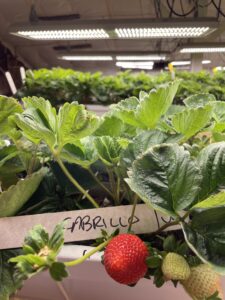
Cabrillo Variety in the initial variety trial
The lighting trial was monitored for light levels. At 100 % power, PPFD was 930, at 75% power, 725, and at 50% 530. This study could not be completed as designed due to facility limitations.
An issue with poor drainage and salt accumulation was found in the trial and it was terminated on May 6. The plants were removed, plastic gutter liners were removed, and holes were drilled in the gutters every 4'. Gutters were filled with high draining media consisting of 1/3 coir, 1/3 perlite, and 1/3 peat. Plants were then replanted into the production trial. Additional plants from the nursery source were used to fill out the additional space. Buckets were used to catch drainage water beneath.
The production trial was then conducted.
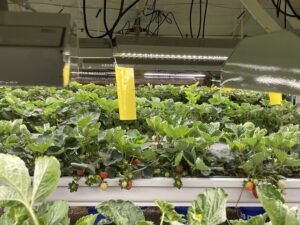
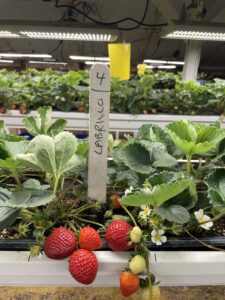
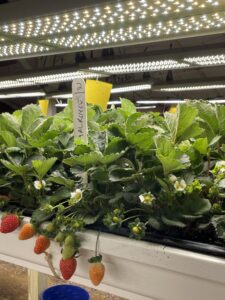
Monterrey variety in the production trial
As the trial was progressing into mid summer, only one month of harvest was possible before production diminished due to heat.
In that month, marketable yields were as follows:
Royal Royce = 7567 g total, 618 berries, 12.2 g/berry
Cabrillo = 7465 g total, 700 berries, 10.7 g/berry
Monterrey = 5301 g total, 433 berries, 12.2 g/berry
San Andreas = 3195 g total, 307 berries, 10.4 g/berry
Sweet Ann = 3024 g total, 206 berries, 11.8 g/berry
Albion = 2518 g total, 204 berries, 12.3 g/berry
Quality was evaluated by tasting and scored as follows: Cabrillo > Royal Royce > Monterrey > San Andreas > Albion >Sweet Ann
Plants were cut back and allowed to regrow to fruit again in September. However, fruit size was small. It was observed that plants were overcrowded so plants were crown thinned to 2 crowns per plant. Blossoms were removed for the next month then plants were allowed to fruit again. Currently, new production is occurring.

To evaluate cooling efficiency of repurposed poultry ventilation equipment on strawberries, temperature was recorded on days where indoor temperatures approach the critical value at mid-morning for strawberries to go into dormancy (86 F). Note that lighting will be provided for 14 hours starting at dusk. Midday and afternoon will be unlighted. Ventilation will be done using tunnel fans with evaporative cooling pads on the opposite end. This information will be used to determine if temperatures can be maintained under the critical value during summer months (June-August).
Temperatures exceeded the critical value (86 F) on the July 27, 28, and 29. This essentially stopped the production of new flowers.
The poultry house cooling system was not able to be fully utilized in this study. This limited summer cooling.
The project was delayed due to the facility not being ready until February. However, much was learned in the project.
The area was cleaned thoroughly, and walls and ceilings were covered with new cleanable sheeting. The floor was excavated to 6 inches and replaced with clean fill.
Variety trials showed that June bearing varieties must have a specific lighting regime to fruit properly. This could not be provided in the facilities as set up. Day neutral varieties had the most potential in the study and were used in a production trial.
The original growing system had issues with drainage and salt accumulation and this was corrected by adding drainage holes and a coarser media.
The production trial lasted one month. Originally it was to be several months; however, summer heat cut the trial short. A current production trial is underway to be conducted throughout the fall, winter, spring and early summer months.
Variable intensity lights worked well but the lighting study could not be completed due to facility limitations. A future lighting study is warranted.
Plants become overcrowded in 3 months and will have to be crown thinned every 12 weeks to keep acceptable berry size.
Runner production is an issue and runners must be removed weekly.
Standard hydroponic nutrient solutions for strawberries produced healthy, productive plants but need to be applied to achieve some drainage each day to avoid salt buildup and leachate should be monitored and when EC values exceed 1.4, a fresh water leaching should be done.
The main disease problem was Powdery Mildew (controlled with Milstop); spider mites need to be controlled (controlled by release of predatory P. persimilis mites). Other occasional pests included aphids and slugs.
The production trial showed that 3 varieties had the most potential: Cabrillo, Royal Royce, and Monterrey. It is estimated that in a 10 month growing cycle, approximately 4 lbs. of marketable strawberries could be produced per plant. The most common size poultry house not longer being used for bird production is 550' x 40'. In this area, 12,000 plants could be grown and would have the potential to produce 48,000 lbs. of strawberries per year with a direct marketing value of over $150,000. Electric costs in the current system for lighting and ventilation are estimated at $4,000 per month and heating at $1,000 per month only in winter months. Full house retrofit costs are estimated at $220,000.
Education & Outreach Activities and Participation Summary
Participation Summary:
Information from these efforts were extended through electronic resources, a field day, several tours, and grower informational meetings . The project was not able to do on-farm training sessions as the system was still being studied but this is planned for the future. An additional goal achieved was to demonstrate how to convert a poultry house to address food safety concerns for produce production. Reports on studies will be posted on the University of Delaware Vegetable and Fruit program website. One article on the project was be posted on the UD Weekly Crop Update blog. One column was written about the project in the Delmarva Farmer regional weekly magazine. One feature article is being published on the University of Delaware web site. One field day was held at the end of project.
One major audience for these educational efforts was current and former poultry growers with empty houses seeking new opportunities to use those houses. Other audiences included extension educators and university researches, USDA researchers, service providers, and Department of Agriculture personnel..
Tours were conducted in November of 2022 for USDA and University researchers and in September and December 2023 for different interested parties.
A talk was given in January 2023 at the Fruit Session of Delaware Agriculture Week on the project and another one is planned for January 2024.
Fruit-talk-2023-Ag-week-indoor-strawberries
Learning Outcomes
Knowledge about the project
Conversion of poultry houses for food safety
Project Outcomes
The Owens farm has been very excited about the research conducted and have been provided support and materials throughout the project.
Visiting farmers have been very impressed. The largest strawberry grower in Delaware has expressed interest in setting up a facility from his visit.
House conversion completion was delayed by 12 weeks and limited the amount of work that could be done in the project time allotted. However, a yield trial was conducted, a production trial was conducted, and system modifications were able to be made and evaluated
Additional research is needed in the following areas: lighting programs, spacing, nutrient optimization, pest management, additional variety evaluations, long term production, and economics.
This project has great potential throughout the Delmarva poultry growing region as there are hundreds of growers with well over 1000 vacant houses that could be converted to indoor growing.
I am retired but am continuing to work on the project. I will be seeking new research partnerships with nearby universities and colleges.
